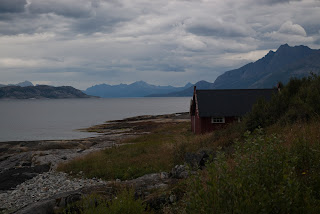 |
| Near Kjerringjoy |
 |
| Two of the farm houses on Kjerringjoy |
But the real attraction of the Bodo region is Saltstraumen maelstrom, one of the largest whirlpools in the world. Jules Verne used it for his book, 20,000 Leagues Under the Sea, The Nordic word was introduced into English by Edgar Allan Poe in his story “A Descent into the Maelström” in 1841. The first element is the name of the district Salten and the last element is the definite form of straum, meaning "stream" or "water flow".
A beautiful high bridge 30 km east of Bodo spans the narrow 150-wide opening between the outer Saltfjord and the large Skjerstadfjord creating the greatest tidal current in the world. The tide can reach 37 kilometers per hour creating vortices ten meters wide and five meters deep. To facilitate the large number of sightseers, parking is available at both ends of the bridge and the bridge has wide walkways along both sides. Tourists also have the option of taking a boat ride into the channel for a more exhilarating experience. Norway’s Coast Guard always has a boat in the area to save those who get too close.
We parked and walked up to the top of the bridge. Linda turned around while I continued on to the other side enjoying the view as I calmed the butterflies in my stomach. While Linda waited she watched a gull family trying to protect an injured baby from a larger predatory gull. Mom pecked at the larger gull while Dad harassed the predator from the air. Eventually the predator gave up and went away leaving the little one to die in peace. When I returned from the other side we headed back to Bodo for dinner and a bit of sleep before catching the 4:00 am ferry next morning.
 |
| Houses below the bridge |











No comments:
Post a Comment